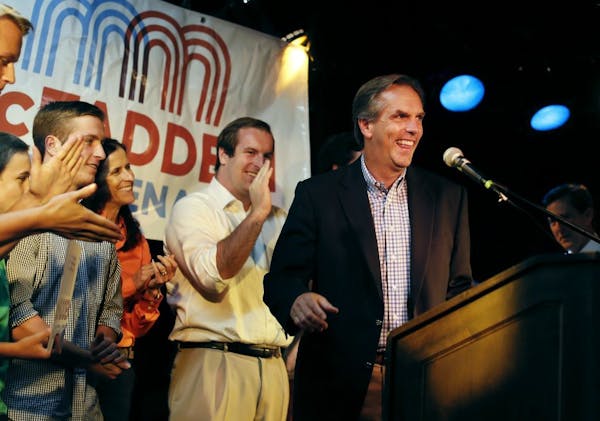Republican Jeff Johnson swept over his three rivals in nearly every part of the state during Tuesday's gubernatorial primary, with a show of support among voters that placed him first or second in 63 of Minnesota's 87 counties.
A Star Tribune analysis shows the Hennepin County commissioner successfully broadened his reach well beyond his home district. Johnson performed well in the metro, but showed surprising strength outstate. He racked up a plurality of votes in much of southern Minnesota, where former state Rep. Marty Seifert had expected to dominate.
Johnson, who entered the lackluster primary armed with his party's endorsement, was the only Republican candidate to do equally well in the metro area and outstate, the analysis showed. A breakdown of the vote shows he won seven of the state's eight congressional districts.
Despite a poor primary turnout overall — fewer than 10 percent of eligible Minnesotans voted — the breadth of Johnson's victory gives the struggling state Republican Party bragging rights and Johnson — who posited himself as the candidate who could knit together the party's various factions — proof that he can do so.
"We have to be united as a Republican Party. We have been divided at times in the past … and it's really hurt us," Johnson said on Wednesday as he gathered at the Capitol with the three men he vanquished. "We can't do that this year."
Across the state, 30 percent of voting Republicans, about 55,000 Minnesotans, backed Johnson. Seifert, Rep. Kurt Zellers and businessman Scott Honour each pulled in about 20 percent of GOP voters statewide.
Each of the three had pockets of support. Honour, of Wayzata, and Zellers, of Maple Grove, did best in the seven-county metro area, but cratered in greater Minnesota. Seifert, of Marshall, netted nearly 28,000 votes in rural Minnesota, narrowly beating Johnson in some parts.
In the 37 counties that Johnson won, he pulled ahead of his second-place contender by 11,553 votes. Seifert won 31 counties, piling up an 8,813-vote lead in those.
But Seifert's rural strategy suffered from a fatal flaw. His support there was strong, but the counties were so sparsely populated that it could not withstand Johnson's turnout in the metro and other parts of the state.
State Republican Party Chairman Keith Downey said that Johnson's reach was surprising. "I think the consistency of his support statewide was a little stronger than we expected," said Downey, whose reputation as a strong party leader rested in part on Johnson's victory.
The 47-year-old former House member won in strong Republican areas, but also in strong Democratic and swing areas. In congressional districts, Johnson won every one save the western part of the Seventh Congressional District. Seifert, who staked his campaign to doing well in rural areas, won that corner of the state.
Turnout lags
Despite the rare GOP gubernatorial primary, Minnesota Republicans largely gave this primary a pass.
According to early, unofficial numbers from the Secretary of State, fewer than 400,000 Minnesotans turned out. In August 2010, when Democrats had a contested gubernatorial primary, about 15 percent of eligible voters showed up.
And while the action Tuesday was largely on the Republican side, slightly more DFLers voted in the gubernatorial and Senate races than did Republicans, even though those elections featured incumbents facing only token opposition. Gov. Mark Dayton got 177,866 votes — more than all four leading GOP candidates combined. Together, Johnson, Seifert, Zellers and Honour got 177,210 votes.
"There's a big red flag for Republicans in a year where it was assumed that our biggest problem would be the turnout for the Democrats," said Ken Martin, chairman of the state DFL Party. "Their own party faithful are not excited enough to show up and vote in a primary."
There were vastly more Democratic votes in the primaries in the urban Fourth and Fifth Congressional Districts, which include Minneapolis and St. Paul. But the Eighth Congressional District DFLers also came out on Tuesday. In the Eighth District, which has toggled between Republicans and Democrats in recent years, nearly 38,000 Democrats voted on Tuesday. That's about 10,000 more Democrats at the polls than Republicans.
But in the rest of the districts, more Republicans found reason to cast ballots, including in the Seventh Congressional District. Republicans hope this year to wrest that western zone from U.S. Rep. Collin Peterson, who has represented the Republican-leaning seat since 1990.
GOP Chairman Downey said he was encouraged rather than discouraged by the turnout. Democrats, he said, always show up in larger numbers for primaries.
"I don't know that there's ever been a year where Republican turnout was essentially a tie," he said. Downey noted that with 182,000 Republicans showing up, the party had beat the decadelong average of GOP primary turnout. It also saw more voters on Tuesday than it had since Minnesota switched in 2010 to August primaries, rather than September.
On a campaign stop in St. Cloud on Wednesday, Republican Senate candidate Mike McFadden was similarly sanguine.
"I don't have any concerns. I've been focused on going around the state," McFadden said. "Whether primary numbers are up or down, they're still a fraction of people that vote in the general election, so I expect that we'll have very good turnout in November because people are dissatisfied and want to see change."
Ricardo Lopez and Abby Simons contributed to this report. Rachel E. Stassen-Berger • Twitter: @RachelSB
Glenn Howatt • Twitter: @glennhowatt
